Page 195 of 395
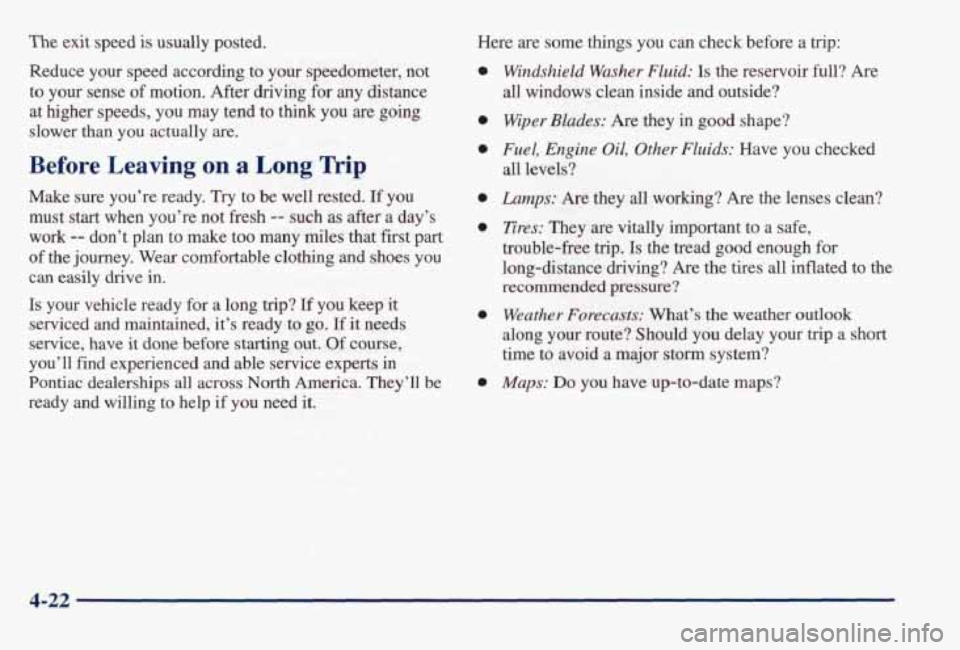
The exit speed is usually posted.
Reduce
your speed according to your speedometer, not
to your sense
of motion. After driving for any distance
at higher speeds, you may tend to
think you are going
slower
than you actually are.
Before Leaving on a Long Trip
Make sure you’re ready. Try to be well rested. If you
must
start when you’re not fresh -- such as after a day’s
work
-- don’t plan to make too many miles that first part
of the journey. Wear comfortable clothing and shoes you
can
easily drive in.
Is your vehicle ready for a long trip? If you keep it
serviced and maintained, it’s ready to
go. If it needs
service, have it
done before starting out. Of course,
you’ll fiid experienced and able service experts
in
Pontiac dealerships all across North America. They’ll be
ready and willing to help
if you need it. Here are some things
you can check before a trip:
e
0
0
0
0
Windshield Washer Fluid: Is
the reservoir full? Are
all windows clean inside and outside?
Wper Blades: Are they in good shape?
Fuel, Engine Oil, Other Fluids: Have you checked
all levels?
Lumps: Are they all working? Are the lenses clean?
Zlres: They are vitally important to a safe,
trouble-free trip.
Is the tread good enough for
long-distance driving? Are the
tires all inflated to the
recommended pressure?
Weather Forecasts: What’s the weather outlook
along your route? Should you delay your trip a short
time
to avoid a major storm system?
Maps: Do you have up-to-date maps?
4-22
Page 196 of 395
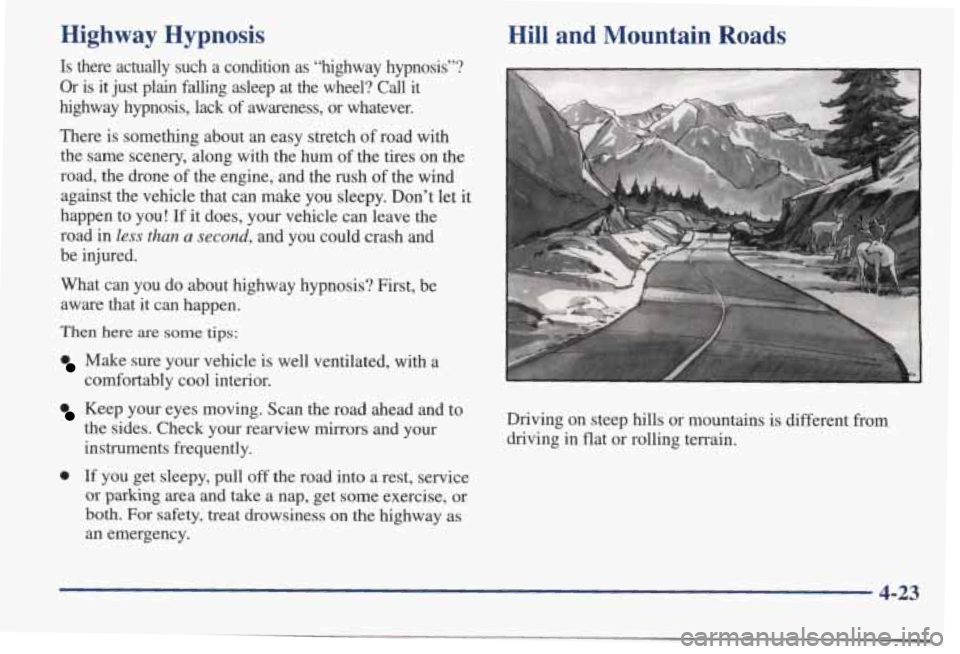
Highway Hypnosis
Is there actually such a condition as “highway hypnosis”?
Or is it just plain falling asleep at the wheel? Call it
highway hypnosis, lack
of awareness, or whatever.
There is something about an easy stretch
of road with
the same scenery, along with the hum
of the tires on the
road, the drone
of the engine, and the rush of the wind
against the vehicle that can make you sleepy. Don’t let it
happen to you!
If it does, your vehicle can leave the
road in
less than a second, and you could crash and
be injured.
What can you do about highway hypnosis? First, be aware that it can happen.
Then here are some tips:
Make sure your vehicle is well ventilated, with a
comfortably cool interior.
Keep your eyes moving. Scan the road ahead and to
the sides. Check your rearview mirrors and
your
instruments frequently.
0 If you get sleepy, pull off the road into a rest, service
or parking area and take a nap, get some exercise, or
both. For safety, treat drowsiness on the highway as
an emergency.
Hill and Mountain Roads
Driving on steep hills or mountains is different from
driving in flat or rolling terrain.
4-23
Page 211 of 395
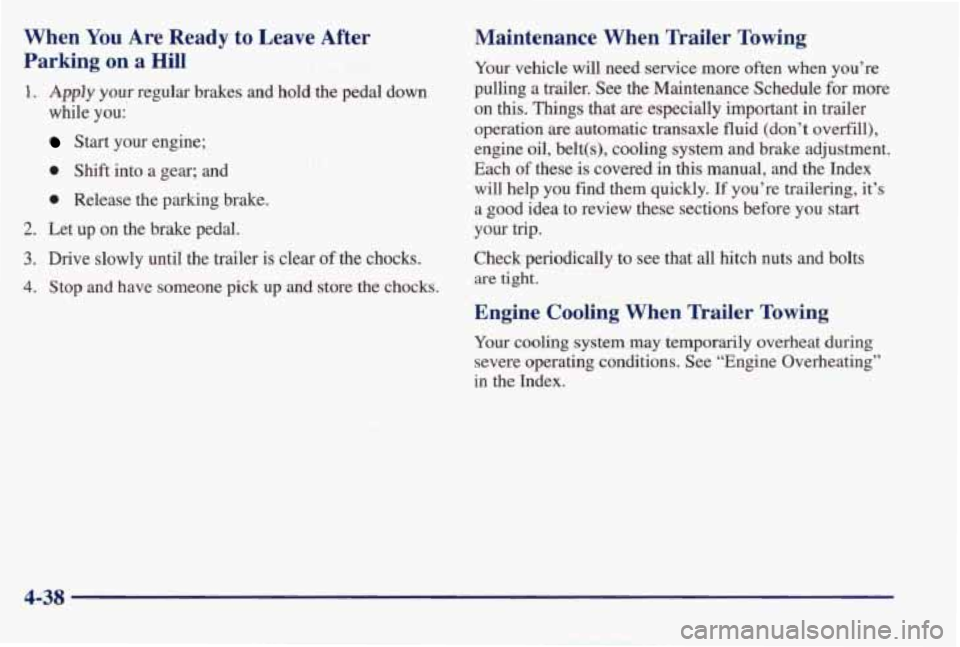
When You Are Ready to Leave After
Parking
on a Hill
1. Apply your regular brakes and hold the pedal down
while you:
Start your engine;
0 Shift into a gear; and
0 Release the parking brake.
2.
Let up on the brake pedal.
3. Drive slowly until the trailer is clear of the chocks.
4. Stop and have someone pick up and store the chocks.
Maintenance When Trailer Towing
Your vehicle will need service more often when you’re
pulling a trailer.
See the Maintenance Schedule for more
on
this. Things that are especially important in trailer
operation
are automatic transaxle fluid (don’t overfill),
engine oil, belt(s), cooling system and brake adjustment.
Each
of these is covered in this manual, and the Index
will help you find them quickly.
If you’re trailering, it’s
a good idea to review these sections before
you start
your trip.
Check periodically to see that all hitch nuts and bolts
Engine Cooling When Ier Towing
fight.
-
Your cooling system may temporarily overheat during
severe operating conditions. See “Engine Overheating”
in the Index.
4-38
Page 220 of 395
10. Attach the cable at least 18 inches (45 cm) away
from the dead battery, but not near engine parts that
move. The electrical connection is just as good
there, but the chance of sparks getting back to the
battery is much less.
11. Now start the vehicle with the good battery and run
12. Try to start the vehicle with the dead battery.
If it won’t start after a few tries, it probably
needs
service.
the engine for a while.
13. Remove the cables in reverse order to prevent
electrical shorting. Take care that
they don’t touch
each other
or any other metal.
A. Heavy Metal Engine Part
B. Good Battery
C. Dead Battery
5-7
Page 221 of 395
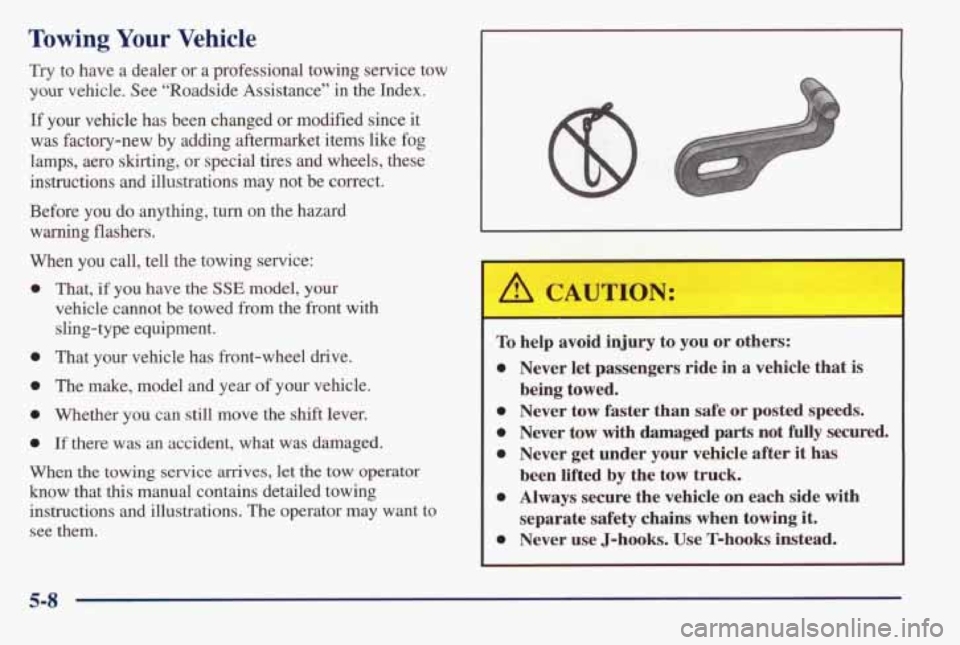
Towing Your Vehicle
Try to have a dealer or a professional towing service tow
your vehicle. See “Roadside Assistance” in the Index.
If your vehicle has been changed or modified since it
was factory-new by adding aftermarket items like fog
lamps, aero skirting,
or special tires and wheels, these
instructions and illustrations may not be correct.
Before you do anything, turn on the hazard
warning flashers.
When you call, tell the towing service:
0
0
0
0
0
That, if you have the SSE model, your
vehicle cannot be towed from the front with
sling-type equipment.
That your vehicle has front-wheel drive.
The make, model and year
of your vehicle.
Whether you can still move
the shift lever.
If there was an accident, what was damaged.
When the towing service arrives, let the tow operator
know that this manual contains detailed towing
instructions and illustrations. The operator may want to
see them.
I A CAUTION:
To help avoid injury to you or others:
0 Never let passengers ride in a vehicle that is
0 Never tow faster than safe or posted speeds.
0 Never tow with damaged parts not fully secured.
0 Never get under your vehicle after it has
been
lifted by the tow truck.
0 Always secure the vehicle on each side with
separate safety chains when towing
it.
0 Never use J-hooks. Use T-hooks instead. being towed.
5-8
Page 222 of 395
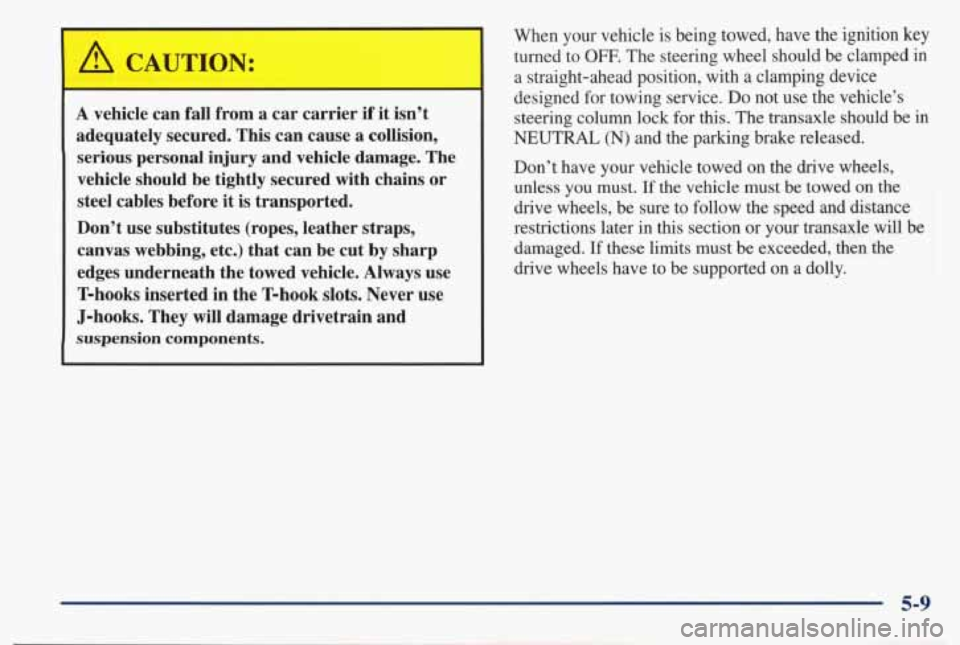
A CAUTION:
A vehicle can fall from a car carrier if it isn’t
adequately secured. This can cause a collision, serious personal injury and vehicle damage. The
vehicle should be tightly secured with chains or
steel cables before it is transported.
Don’t use substitutes (ropes, leather straps,
canvas webbing, etc.) that can be cut
by sharp
edges underneath the towed vehicle. Always use
T-hooks inserted
in the T-hook slots. Never use
J-hooks. They will damage drivetrain and
suspension components.
When your vehicle is being towed, have the ignition key
turned to
OFF. The steering wheel should be clamped in
a straight-ahead position, with a clamping device
designed for towing service.
Do not use the vehicle’s
steering column lock for this. The transaxle should be
in
NEUTRAL (N) and the parking brake released.
Don’t have your vehicle towed
on the drive wheels,
unless you must.
If the vehicle must be towed on the
drive wheels, be sure to follow the speed and distance
restrictions later
in this section or your transaxle will be
damaged.
If these limits must be exceeded, then the
drive wheels have to be supported on a dolly.
5-9
Page 229 of 395
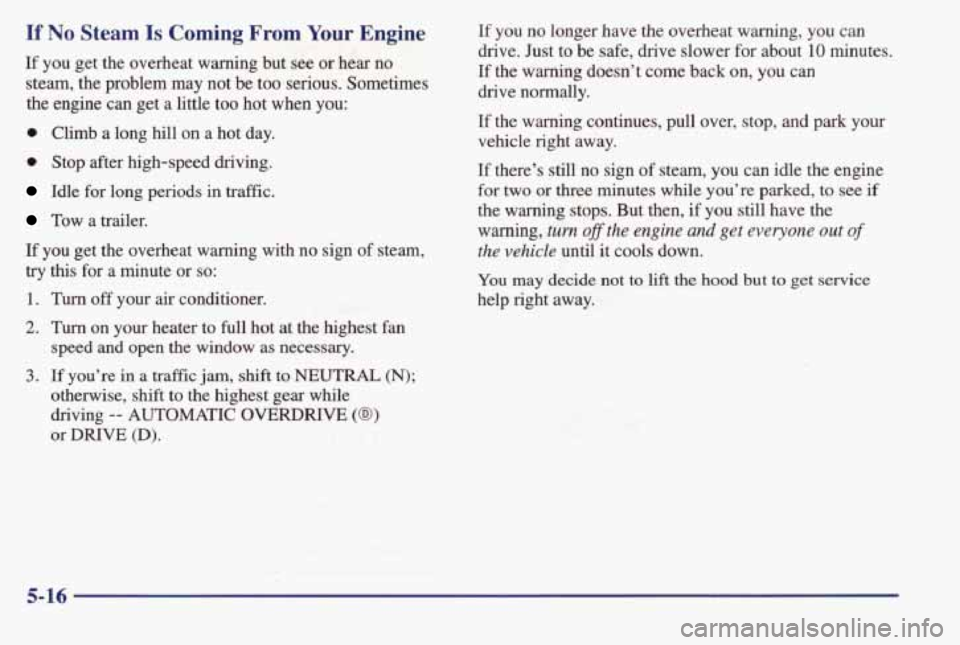
If No Steam Is Coming From Your Engine
If you get the overheat waming but see or hear no
steam, the problem may not be too serious. Sometimes the engine can get a little too hot when you:
0 Climb a long hill on a hot day.
0 Stop after high-speed driving.
Idle for long periods in traffic.
Tow a trailer.
If you get the overheat warning with no sign of steam,
try this for a minute or so:
1. Turn off your air conditioner.
2. Turn on your heater to full hot at the highest fan
speed
and open the window as necessary.
3. If you’re in a trafEc jam, shift to NEUTRAL (N);
otherwise, shift to the highest gear while
driving
-- AUTOMATIC OVERDRIVE (@)
or DRIVE (D).
If you no longer have the overheat warning, you can
drive. Just to be safe,
drive slower for about 10 minutes.
If the warning doesn’t come back on, you can
drive normally.
If the warning continues, pull over, stop, and park your
vehicle right away.
If there’s
still no sign of steam, you can idle the engine
for two or three minutes while you’re parked, to see if
the warning stops. But then, if you still have the
warning,
turn oflthe engine and get everyone out of
the vehicle until it cools down.
You may decide not to lift the hood but to get service
help right away.
5-16
Page 231 of 395
The coolant level should be at or above the FULL
COLD mark.
If it isn’t, you may have a leak in the radiator hoses,
heater hoses, radiator, water pump
or somewhere else in
the cooling system.
A CAUTION:
Heater and radiator hoses, and other engine
parts,
can be very hot. Don’t touch them. If you
do, you coul be burned.
Don’t
run the engine if there is a leak. If you run
the engine, it could lose all coolant. That could
cause an engine fire, and you could be burned.
Get any leak fied before you drive the vehicle.
NOTICE:
Engine damage from running your engine
without coolant isn’t covered by
your warranty.
If there seems to be no leak, with the engine on, check to
see if the electric engine cooling fans are running. If the
engine is overheating, both fans should be running. If
they aren’t, your vehicle needs service.
5-18